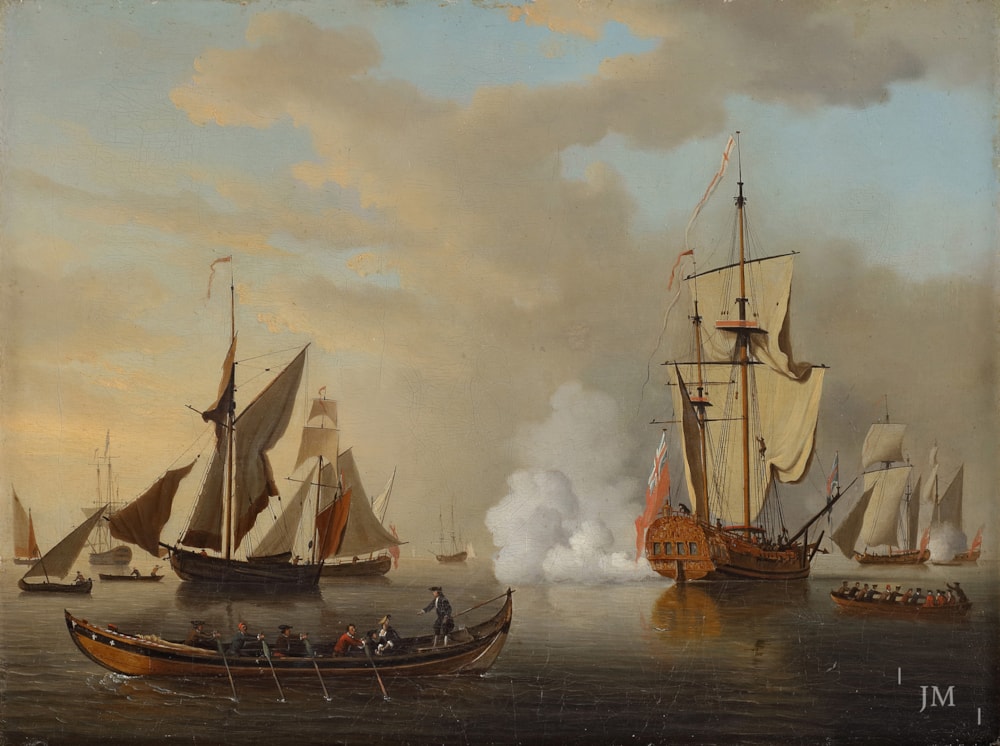Samuel Scott ( 1702 - 1772 )
An English Yacht and other Shipping becalmed


An English Yacht and other Shipping becalmed
oil on canvas
17 x 23 in. (43 x 58.5 cm.)
with carved and gilded English frame
item sold
Such is the scarcity of Samuel Scott’s work that it has not been possible to find any record of a painting by the artist passing through our firm’s hands in ninety-four years of activity. As with many eighteenth-century British artists, inadequate biographical information has long gone hand-in-hand with a fundamental misunderstanding of his work and little or no discernment of his authentic productions. Even well into the twentieth century, generic views of London and the River Thames in the style of an English Canaletto were attributed to Scott, almost by default. His contemporaries, however, did not consider him a topographical artist at all; instead he was widely regarded as the Navium et Prospectum Marinorum Pictor (‘painter of ships and sea views’) which he labelled himself on the engraving of his portrait by Thomas Hudson. One obituary notice recalled ‘..an artist so universally admired for his painting of Sea-Pieces and Shipping, as to be esteemed the English Vandevelde.’ In the most recent, and most authoritative, survey of Samuel Scott published in 1982 Richard Kingzett began his ‘Introduction’ as follows: ‘The first Exhibition entirely devoted to Samuel Scott was arranged at Agnew›s in 1951. Unfortunately when the 52 pictures and drawings chosen for the occasion were assembled in one gallery it became apparent that works by at least six different painters were on view.’ In his Catalogue of all the artist ’s surviving known works which follows, there are only twenty-one marine paintings not of naval battles. That our ‹calm› is not among them reminds us that no list of an Old Master’s work can ever be considered exhaustive, but it also shows how, within the interval of thirty years, ideas about what Scott’s paintings really looked like had coalesced to whittle down the number of his autograph paintings to a surprisingly small body of work.
Our painting probably belongs to the early part of Scott’s career, when he leant heavily on the work of Willem Van de Velde the Younger. The latter’s death in 1707 resulted in large numbers of the drawings from the Van de Velde studio being bought by collectors, many of them marine artists like Scott who were quick to appreciate the towering stature of the Van de Veldes and their legacy. Van de Velde ‘sea-pieces’ were unashamedly copied and re-interpreted not only by Scott, but by his younger contemporary and a founding member of the Royal Academy of Arts, Dominic Serres. Both Serres and Charles Gore even took original Van de Velde sheets and reworked them.
The present painting purposely evokes the ‘calms’ of the English period of Van de Velde the Younger, which were becoming so popular with collectors in England; the yacht is very much in the seventeenth-century mould, and could even be one of that flotilla of such craft so beloved by King Charles II and his brother James, Duke of York, while the general arrangement of the various vessels strung out across the composition, with the billowing gun-smoke at its centre, is consistent with an earlier style. To cast shadow across the shipping on one side, and highlight a principal, single craft is pure Van de Velde, too. The recent cleaning of this canvas has revealed the paint surface to be miraculously well-preserved, with even details of the rigging in the far-off shipping still visible. (In many marine paintings of this period, one finds that the more delicate and fine brushwork has been worn away by over-enthusiastic cleaning in the past.) As a result it is rewarding to compare, say, the exquisite handling of the masts and shrouds of the yacht and their backdrop of limp, weathered canvas with similar passages in any number of pictures by ‘Vandervell’, as he was sometimes known in this period. In fact, from the deck upwards one could easily be persuaded of the hand of the Dutch master himself. The fact that the painting is later in period by the unusual, decorative eight-oared gig featured prominently lower left and its distinctively Georgian-looking crew, now more elaborately drawn than in earlier marine paintings; among them are a mother and child, with the latter trailing a fishing rod in the water just beside him. Just beyond the prow of their boat is an incongruous lateen-rigged one which, again, suggests Scott creating his own distinct style, even if it meant straying from the conventions of maritime accuracy. By breathing new life into an accepted idiom, and for those not wishing to commemorate a particular naval engagement, Scott found success serene ‘sea-pieces’ such as ours.

